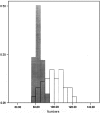The dynamics of the roo transposable element in mutation-accumulation lines and segregating populations of Drosophila melanogaster
- PMID: 17890368
- PMCID: PMC2013678
- DOI: 10.1534/genetics.107.076174
The dynamics of the roo transposable element in mutation-accumulation lines and segregating populations of Drosophila melanogaster
Abstract
We estimated the number of copies for the long terminal repeat (LTR) retrotransposable element roo in a set of long-standing Drosophila melanogaster mutation-accumulation full-sib lines and in two large laboratory populations maintained with effective population size approximately 500, all of them derived from the same isogenic origin. Estimates were based on real-time quantitative PCR and in situ hybridization. Considering previous estimates of roo copy numbers obtained at earlier stages of the experiment, the results imply a strong acceleration of the insertion rate in the accumulation lines. The detected acceleration is consistent with a model where only one (maybe a few) of the approximately 70 roo copies in the ancestral isogenic genome was active and each active copy caused new insertions with a relatively high rate ( approximately 10(-2)), with new inserts being active copies themselves. In the two laboratory populations, however, a stabilized copy number or no accelerated insertion was found. Our estimate of the average deleterious viability effects per accumulated insert [E(s) < 0.003] is too small to account for the latter finding, and we discuss the mechanisms that could contain copy number.
Figures



Similar articles
-
Accumulation of transposable elements in laboratory lines of Drosophila melanogaster.Genetica. 1997;100(1-3):167-75. Genetica. 1997. PMID: 9440270 Review.
-
Long-term evolution of the roo transposable element copy number in mutation accumulation lines of Drosophila melanogaster.Genet Res (Camb). 2011 Jun;93(3):181-7. doi: 10.1017/S0016672311000103. Epub 2011 May 6. Genet Res (Camb). 2011. PMID: 21554776
-
Accumulation of transposable elements in the genome of Drosophila melanogaster is associated with a decrease in fitness.J Hered. 2004 Jul-Aug;95(4):284-90. doi: 10.1093/jhered/esh050. J Hered. 2004. PMID: 15247307
-
Mechanisms regulating the copy numbers of six LTR retrotransposons in the genome of Drosophila melanogaster.Chromosoma. 2002 Feb;110(8):511-8. doi: 10.1007/s00412-001-0174-0. Chromosoma. 2002. PMID: 12068968
-
Maintenance of transposable element copy number in natural populations of Drosophila melanogaster and D. simulans.Genetica. 1997;100(1-3):161-6. Genetica. 1997. PMID: 9440269 Review.
Cited by
-
LTR retroelements in the genome of Daphnia pulex.BMC Genomics. 2010 Jul 9;11:425. doi: 10.1186/1471-2164-11-425. BMC Genomics. 2010. PMID: 20618961 Free PMC article.
-
Sequencing of pooled DNA samples (Pool-Seq) uncovers complex dynamics of transposable element insertions in Drosophila melanogaster.PLoS Genet. 2012 Jan;8(1):e1002487. doi: 10.1371/journal.pgen.1002487. Epub 2012 Jan 26. PLoS Genet. 2012. PMID: 22291611 Free PMC article.
-
qPCR as a Selective Tool for Cytogenetics.Plants (Basel). 2022 Dec 23;12(1):80. doi: 10.3390/plants12010080. Plants (Basel). 2022. PMID: 36616209 Free PMC article.
-
Novel Insights into Plant Genome Evolution and Adaptation as Revealed through Transposable Elements and Non-Coding RNAs in Conifers.Genes (Basel). 2019 Mar 18;10(3):228. doi: 10.3390/genes10030228. Genes (Basel). 2019. PMID: 30889931 Free PMC article. Review.
-
A unique cluster of roo insertions in the promoter region of a stress response gene in Drosophila melanogaster.Mob DNA. 2019 Mar 13;10:10. doi: 10.1186/s13100-019-0152-9. eCollection 2019. Mob DNA. 2019. PMID: 30911338 Free PMC article.
References
-
- Abrusán, G., and H. J. Krambeck, 2006. Competition may determine the diversity of transposable elements. Theor. Popul. Biol. 70: 364–375. - PubMed
-
- Ávila, V., and A. García-Dorado, 2002. The effects of spontaneous mutation on competitive fitness in Drosophila melanogaster. J. Evol. Biol. 15: 561–566.
-
- Bartolomé, C., and X. Maside, 2004. The lack of recombination drives the fixation of transposable elements on fourth chromosome of Drosophila melanogaster. Genet. Res. 83: 91–100. - PubMed
-
- Biémont, C., and C. Vieira, 2006. Junk DNA as an evolutionary force. Nature 443: 521–524. - PubMed
Publication types
MeSH terms
Substances
LinkOut - more resources
Full Text Sources
Molecular Biology Databases

